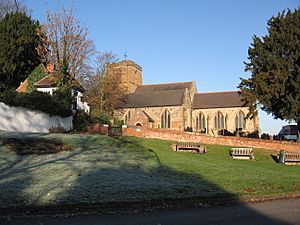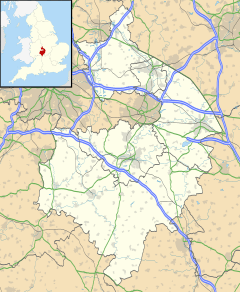Mancetter facts for kids
Quick facts for kids Mancetter |
|
|---|---|
 St. Peter's parish church |
|
| Population | 2,449 (2001 census) |
| OS grid reference | SP3296 |
| Civil parish |
|
| District |
|
| Shire county | |
| Region | |
| Country | England |
| Sovereign state | United Kingdom |
| Post town | Atherstone |
| Postcode district | CV9 |
| Dialling code | 01827 |
| Police | Warwickshire |
| Fire | Warwickshire |
| Ambulance | West Midlands |
| EU Parliament | West Midlands |
| UK Parliament |
|
| Website | Welcome to Mancetter Parish |
Mancetter is a small village in North Warwickshire, England. It's located where an old Roman road called Watling Street crosses the River Anker. In 2011, about 2,339 people lived here. Mancetter is right next to the town of Atherstone.
Contents
A Look at Mancetter's Past
Roman Times in Mancetter
Long ago, when the Romans were in Britain, they built a small station along Watling Street near the river. You can still see the remains of this rectangular earthwork today. Around 50 AD, a much bigger Roman army camp, called a legionary fortress, was built here. It was home to the Legio XIV Gemina, a Roman legion, before they moved to Wroxeter around 55 AD.
A settlement called Manduessedum grew up around this fortress. Many historians believe that Mancetter was the place where a very important battle happened. This was the Defeat of Boudica, where the Roman army, led by Gaius Suetonius Paulinus, fought against a group of British people led by the famous Queen Boudica. The exact spot of this battle is still a mystery.
Mancetter Through the Centuries
Mancetter isn't mentioned in the Domesday Book from 1086, which was a big survey of England. However, in 1196, a man named Walter de Mancetter gave land to help start the local parish church.
The Church of England parish church of Saint Peter still has parts of its walls from the 12th century. The church was updated in the early 13th century, and a north aisle was added later in that century. The bell tower, south aisle, and the upper windows (called a clerestory) were probably added in the 15th century. A porch was added in the early 17th century. The church has been repaired several times over the years.
The church's tower has five bells. The oldest bell was made around 1350, and another in the early 1500s. The other three bells were added in the mid-1600s.
Mancetter Manor is an old house built around 1330. It's made with a timber-framed style. Over the years, parts of the house were changed or added, like a new floor in the great hall around 1480 and a south wing around 1580.
What's in a Name? Mancetter's Meaning
The name "Mancetter" comes from a very old Celtic name, Manduessedum. This name was first written down in the 4th century. It combines two old words:
- Mandu – which means 'horse' or 'pony'.
- Essedo – which means 'horse chariot'.
The second part of the modern name, "-cetter," comes from an Old English word, -ceaster. This word meant 'a city' or 'an old Roman fort'. By the time of the Norman Conquest in 1066, ceaster sounded a lot like "Chester." The way "-cetter" is spelled shows how some French-speaking Norman clerks found it tricky to pronounce English sounds like "ch" and "st."
Notable People
- John Sinclair (1860–1938), a physician (a type of doctor).


